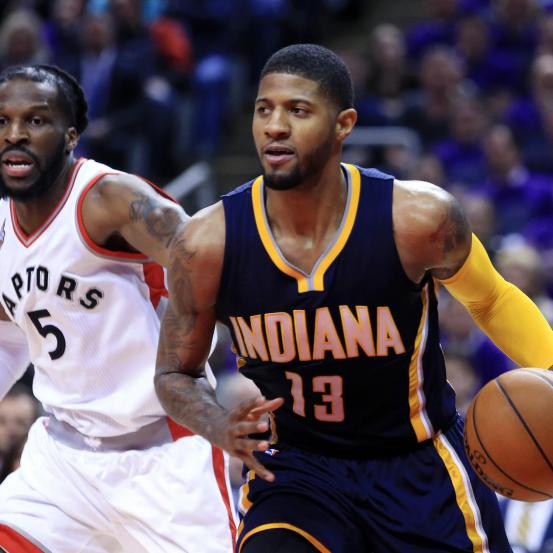- Commissioner’s statement on Ventura, Marte
- Ronnie O’Sullivan: Masters champion ‘felt so vulnerable’ in final
- Arron Fletcher Wins 2017 WSOP International Circuit Marrakech Main Event ($140,224)
- Smith challenges Warner to go big in India
- Moncada No. 1 on MLB Pipeline’s Top 10 2B Prospects list
- Braves land 2 on MLB Pipeline’s Top 10 2B Prospects list
- Kingery makes MLB Pipeline’s Top 10 2B Prospects list
- New Zealand wrap up 2-0 after Bangladesh implosion
- Mathews, Pradeep, Gunathilaka to return to Sri Lanka
- Elliott hopes for rain for Poli
Blueprint for Upsets in 1st Round of the 2016 NBA Playoffs
- Updated: April 19, 2016

Most NBA playoff brackets are not made to be busted.
Superior teams usually prevail over the course of a seven-game series. Exhibit A: this year. The San Antonio Spurs and Golden State Warriors aren’t facing real playoff teams; the Portland Trail Blazers don’t have enough star power to fend off the Los Angeles Clippers; and the Dallas Mavericks can only unseat the Oklahoma City Thunder if Kevin Durant continues vomiting career-worst shooting showings.
That leaves a very specific set of Eastern Conference teams ferrying the hopes and dreams of upset enthusiasts. These sleeper contestants may not end up winning their respective series, but they are the most likely to create a wrinkle inside an otherwise predictable postseason caste.
Boston Celtics
At first glance, the Boston Celtics shouldn’t be an upset candidate. They are the Eastern Conference’s No. 5 seed, playing the fourth-place Atlanta Hawks. These postseason matchups don’t yield surprise winners, regardless of who emerges victorious—especially when participants share the same regular-season record.
Game 1 didn’t do much, if anything, to soften that stance, with the Hawks barely piecing together a 102-101 victory. But Atlanta has been a sneaky tough opponent for Boston all year.
The Celtics dropped the regular-season series 3-1 and trailed by as many as 19 points in the opening tilt. It took a second-half blitz for them to put the pressure on the Hawks. And they still lost.
This 1-0 gap is made more harrowing by Boston’s bruised bodies.
Avery Bradley isn’t expected to return before the first round is over after suffering a hamstring injury, per Chris Forsberg of ESPN.com, while both Kelly Olynyk (shoulder) and Marcus Smart (finger) are banged up, according to the Boston Globe’s Adam Himmelsbach.
Head coach Brad Stevens can’t even displace the Hawks from their comfort zone with Boston’s trademark five-out lineups. As Bret LaGree wrote for Hoopinion:
It’s widely recognized going small helps the Celtics less against the Hawks than it does against most teams because the Hawks, since Tiago Splitter was lost for the season, already play 5 out all the time. Going small has less positive impact when Jae Crowder appears incapable of keeping Jeff Teague in front of him. Stevens can’t even hide Isaiah Thomas on Kent Bazemore if Bazemore moves without the ball because Thomas will get caught ball-watching. All the Celtics guards and wings (with the exception of the now, sadly absent, Avery Bradley) are drawn to the ball, leaving them susceptible to quick, constant, and sound ball and player movement. Which is understandable, given that I started this by talking about how they have to create transition opportunities to score consistently. Such is the stress of being a good team confronting a challenge directed squarely at what you believe makes you good.
Still, if there’s any team deep enough to weather this invasion of injuries and tactical warts, it’s the Celtics. Their bench ranked in the top five of offensive and defensive efficiency during the regular season, per HoopsStats.com; the San Antonio Spurs are the only other playoff squad that can say the same.
There is a “Steer into the skid” feeling when it comes to Boston’s smaller lineups. Those combinations can give up a ton of offensive rebounds and don’t pose as much upside without Bradley’s shooting. But they create a boatload of mismatches, even against Atlanta, with their constant offensive probing.
And while the Celtics defense has been steadily slipping, dropping from the top 10 of points allowed per 100 possessions since March, it is far from inept.
More than 55 percent of the Hawks’ looks were contested in Game 1. They just shot nearly 48 percent in those situations. They whiffed on a bunch of wide-open opportunities, but …
continue reading in source www.bleacherreport.com
